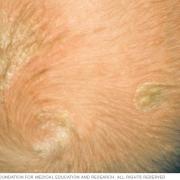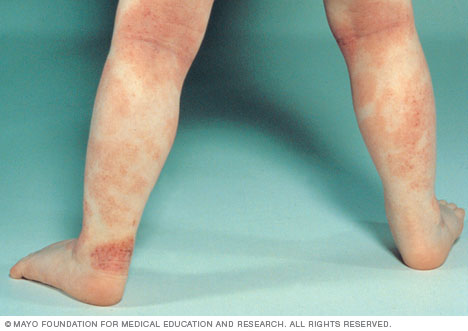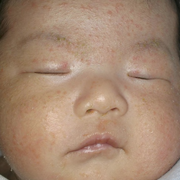Cradle Cap, Eczema, and Infant Acne Explained
There are several common newborn care skin conditions; cradle cap, eczema and infant acne. How can they be -and should they be- treated? This blog Cradle Cap, Eczema, and Infant Acne Explained can help.

Cradle Cap, Eczema, and Infant Acne Explained
What is Cradle Cap?
Cradle cap is scales and redness on a baby’s scalp. When this rash occurs on the scalp alone, it’s known as cradle cap. It may start as scaling and redness of the scalp and can also extend to the face and diaper area, too. When it does, pediatricians call it seborrheic dermatitis (because it occurs where there are the greatest number of oil producing sebaceous glands).

Seborrheic dermatitis is a noninfectious skin condition that’s very common in infants, usually beginning in the first weeks of life and slowly disappearing over a period of weeks or months. It is rarely uncomfortable or itchy.
Treatment: Cradle cap is not harmful and will typically go away on its own by baby’s first birthday. It can be treated, by washing hair frequently with a mild baby shampoo and using a soft brush to remove the scales. Some doctors recommend a stronger, medicated shampoo or cortisone cream. These may remove the scales quickly but can be irritating to baby’s sensitive skin. Only use them after consulting a pediatrician.
It is not recommended to use baby oil or mineral oil on cradle cap. Doing so allows the scales to build up on the scalp, particularly over the fontanelle, or soft spot on baby’s head. Sometimes a yeast infection may form on the crease areas of the skin (rarely on the scalp.) If this happens, the area will be red and itchy. Seek the care of a pediatrician who may prescribe an anti-yeast cream.
What is infant eczema?
Infant eczema known as atopic dermatitis (AD), is a chronic skin problem that causes red, dry, and itchy rashes. In babies, the rashes usually occur on the face or scalp or folds of skin. According to the American Academy of Pediatrics, it is the most common skin problem treated by pediatric dermatologists. Eczema can be hereditary and occur in conjunction with allergies or asthma. Also baby’s saliva from drooling can provoke irritation. Eczema in babies tends to be worse in the drier, winter months.

Eczema. See more examples of eczema via the Mayo Clinic
Treatment:
Infant eczema usually clears up before 4 years of age. Before then however, different triggers cause eczema so treatment can vary.
Parents should contact their pediatrician for specific direction but common non-medical treatments include:
- eliminating certain foods from baby’s diet – we should note that eliminating certain foods to see if baby’s eczema clears up is appropriate for children on solid food, there is conflicting advice on elimination diets for exclusively breastfed babies.
- The AAP suggests that “lactating mothers with infants at high risk of developing AD should avoid peanuts and tree nuts, and should consider eliminating eggs, cow’s milk, and fish from their diets.”
- However, La Leche League states that mother’s almost never need to limit their diets. So, parents can try an elimination diet while breastfeeding or use the other tips below.
- using mild soaps, moisturizers and detergents specially made for sensitive baby skin
- dressing baby in lightweight, loose fabrics or try skin -soothing fabrics
- putting a cool-mist humidifier in baby’s bedroom
- In some cases, a prescription cream or oral medicine may be prescribed.
What is infant acne?
Infant acne is harmless acne that is often caused by exposure to maternal hormones in utero. Many babies develop infant acne around a few weeks of age, and in most cases, the acne is gone before baby reaches six months. While we think of acne appearing most often on the face, it can also occur on baby’s chest or back.

Treatment:
Unlike acne in adolescents and adults, infant acne requires no special treatment or medication. Clean the area daily with warm water, mild soap, and pat gently dry. Since baby acne is not caused by dirt, do not over wash the area, which can cause irritation. Since infant acne usually clears up within a few months, it is not cause for concern. However if the bumps look unusual, parents should mention the acne to their pediatrician to rule out other skin conditions.
The thing to remember about these three skin conditions is that they just happen. Parents aren’t doing anything wrong when these conditions present, and there is usually no reason for nursing mothers to change their own diets.
Skin issues are usually simply due to baby’s little body adjusting to the world outside the womb.
Categories
- Baby Care Classes
- Baby Care How-To's
- Baby Sleep
- Family Activities with Baby
- Feeding
- Franchise & Company Info
- Hiring Help
- Our Favorites
- Postpartum Health
- Safety & First Aide
- Twins & Multiples
- zArchives
